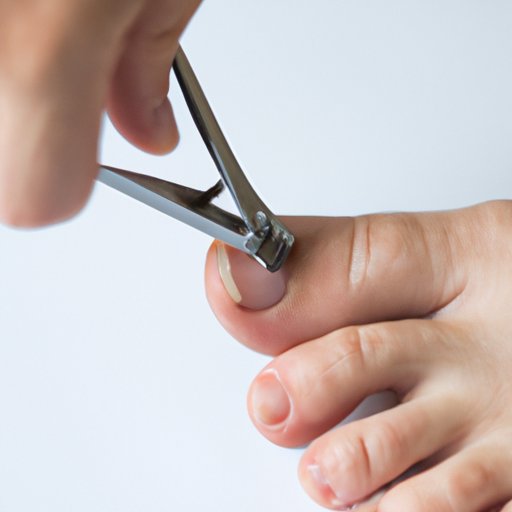
I. Introduction
Ingrown toenails are a common condition in which the nail grows into the surrounding skin, causing pain, discomfort, and inflammation. Knowing the symptoms, causes, prevention, and treatment options is essential to alleviate the problem and avoid complications. In this article, we’ll guide you through all you need to know about ingrown toenails, from symptoms to home remedies and when to see a medical professional.
II. Symptoms of an Ingrown Toenail
The most common symptoms of an ingrown toenail include:
- Pain and tenderness around the affected area.
- Redness and inflammation on the skin surrounding the nail.
- Discharge or pus coming from the nail area in severe cases of infection.
- Difficulty walking or wearing closed-toed shoes due to discomfort and pain.
If you experience any of those symptoms, you might have an ingrown toenail that requires proper attention and care.
III. Causes of Ingrown Toenails
Several factors can contribute to the development of an ingrown toenail, including:
- Improper nail cutting techniques: cutting nails too short or at an angle can cause the nail to grow into the skin.
- Tight-fitting shoes: wearing shoes that squeeze or pinch the toes can push the nail towards the skin’s side.
- Genetics: some people might have a predisposition to ingrown toenails due to the natural shape of their toenails.
- Foot infections or injuries: trauma or infections can affect the nail’s growth, causing it to dig into the skin.
Understanding those causes can help you take preventive measures and lower the chance of developing an ingrown toenail.
IV. Prevention of Ingrown Toenails
Here are some useful tips to prevent ingrown toenails:
- Proper nail cutting techniques: cut the nails straight across without rounding the corners, avoid cutting them too short.
- Adequate foot hygiene: keep the feet clean and dry, moisturize the skin, and change socks regularly.
- Wearing comfortable and well-fitting shoes: choose shoes that provide enough space and support for your toes, and avoid high heels or tight-fitting shoes.
- Avoiding injury to the toes: protect your toes from trauma and avoid picking at the nails or surrounding skin.
Following those preventive measures can save you a lot of trouble and help you enjoy healthy and pain-free feet.
V. Home Remedies for Ingrown Toenails
If you have a mild case of an ingrown toenail, some simple home remedies might help relieve the pain and reduce inflammation:
- Soaking the affected toe in warm saltwater: combine a tablespoon of salt with a basin of warm water and soak the toe for 15-20 minutes, repeat several times a day.
- Applying tea tree oil to the affected area: put a drop of tea tree oil on a cotton ball and apply it to the affected area, leave it for 10-15 minutes, and rinse well.
- Using a cotton ball to cushion the affected toe: place a small cotton ball under the edge of the nail to lift it slightly and prevent it from digging into the skin.
Other than these simple remedies, avoid using any sharp instrument on the affected area or trying to cut the nail yourself, which can worsen the condition and lead to infection.
VI. Treatment Options for Ingrown Toenails
If the ingrown toenail is severe or accompanied by an infection, you might need medical intervention to manage the condition, which can include:
- Use of antibiotics for infections: if the affected area is infected, the doctor might prescribe antibiotics to clear the infection and reduce the inflammation.
- Surgery to remove the affected nail: in severe cases, the doctor might need to remove the affected portion of the nail or the entire nail to enable the skin to heal.
- Application of topical creams or ointments: the doctor might recommend or prescribe some ointments or creams to reduce swelling and inflammation and promote healing.
It’s essential to follow the doctor’s instructions strictly to avoid further complications and promote quick recovery.
VII. When to See a Doctor
Though ingrown toenails are not usually severe, in some cases, they require immediate medical attention. You should see a doctor if:
- The pain and swelling worsen despite home care.
- There is pus or discharge from the affected area, indicating infection.
- The affected toe becomes feverish or shows other signs of spreading infection.
- You have diabetes or a compromised immune system.
Don’t ignore any signs of infection or worsening, as they can lead to severe complications if not treated on time.
VIII. Conclusion
We hope this article provided you with valuable insights into ingrown toenails, their symptoms, causes, and treatment options. Remember, preventing ingrown toenails is better than treating them later, so practice healthy nail care habits and foot hygiene to avoid the condition altogether. And if you do have an ingrown toenail, be sure to seek medical care when needed to ensure a quick and effective recovery.




